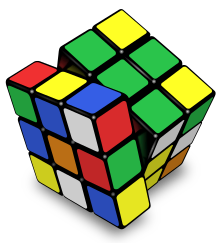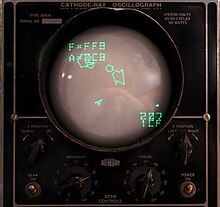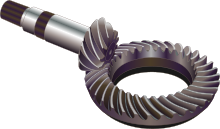Vector graphic
A vector graphic is a computer graphic that is composed of graphic primitives such as lines, circles, polygons or general curves ( splines ). Mostly, vector graphics mean representations whose primitives can be described two-dimensionally in the plane . An image description that is based on three-dimensional primitives is called a 3D model or scene , and the generation of two-dimensional line and area graphics and photo-realistic images from such 3D models is called image synthesis or rendering .
For example, to save the image of a circle, a vector graphic requires at least two values: the position of the center of the circle and the diameter of the circle. In addition to the shape and position of the primitives, the color, line width, various fill patterns and other data that determine the appearance may also be given.
properties
|
|
|
 |

|
 |

|
| Vector graphic | Raster graphics |
Illustrations are based, unlike bitmaps , not on a grid in which each pixel (picture element, English picture element , pixel) is assigned a color value, but on an image description that exactly defines the objects from which the image is constructed. For example, a circle can be completely described in a vector graphic using the position of the center point, radius, line width and color; only these parameters are saved. Compared to raster graphics, vector graphics can therefore often be saved with significantly less space. One of the essential features and advantages over raster graphics is the stepless and loss-free scalability .
The term “vector graphic” is related to the fact that the vector screens that were widespread until the 1980s displayed lines (“ vectors ”) with a cathode ray . Vector graphics in today's sense do not just consist of lines, but can also allow other basic shapes. Vector graphics must be rasterized in order to be displayed on raster screens that are common today .
The generation of vector graphics is the subject of geometric modeling and is usually done using a vector graphics program or directly with a markup language . With certain restrictions, raster graphics can be converted into vector graphics by means of so-called vectorization ; some text recognition programs are based on a vectorization algorithm. In the meantime, common vector graphics programs offer functions that allow vector graphics to be saved with color gradients and levels of transparency and thus to describe a large number of images satisfactorily. In contrast to raster graphics, such vector graphics can also be changed and transformed conveniently and without loss .
Rendering effort
The strength of vector graphics in general is that it is resolution independence; That is, they are suitable for reproduction (screen, printing) in any resolution. However, this always requires an elaborate “rendering” of the vector format into a raster format. A disadvantage of vector graphics compared to raster graphics is an unknown, content-dependent rendering effort (in terms of computing time and working memory). Raster graphics have i. A. the advantage that the rendering effort is constant and independent of the content. To minimize this disadvantage of vector graphics, Wikipedia, for example, provides server-side pre-rendered raster graphics preview images of SVG vector graphics in several resolutions.
Applications


The strength of vector graphics lies in representations that can be satisfactorily described as a compilation of graphic primitives, for example diagrams or company logos . They are not suitable for scanned images and digital photos , which are naturally captured as raster graphics and cannot be converted without loss. Vector formats also reach their limits in complex rendered images, which are also calculated directly as raster graphics. However, more and more companies are specializing in the vectorization of raster graphics. This is of particular interest for large-scale image advertising, vehicle lettering or when vectorization is used as a graphic effect.
Vector graphics can be output directly on different materials with the help of plotters (line recorders) or laser markers without prior screening .
Graphics applications
Vector-based drawing programs can be used to create illustrations, especially for creating logos . The 3D scenes generated by 3D modeling tools can also be viewed as vector graphics.
Page description languages
Vector graphics make it possible to describe documents regardless of the resolution of the output device. With the help of a vector graphics-capable page description language such as PostScript or the resulting Portable Document Format (PDF), documents, in contrast to raster graphics, can be displayed or printed with the highest possible resolution on screens without loss.
Office packages
There are more or less extensive drawing functions (shapes) in Office packages . The graphics created in this way are vector graphics. Diagrams are also vector graphics. More complex fills are rasterized for output. For non-photorealistic clipart is WMF Windows a common vector graphics file format.
Computer fonts
So-called outline fonts , which describe the outlines of each character as vector graphics, are predominantly used on current computer systems . Important formats are TrueType , PostScript and OpenType .
Computer games
Early arcade games used vector graphics. The first was Spacewar! from 1962. Also known are Lunar Lander (Atari, 1979), Battlezone (Atari, 1980) and Star Wars (color vector graphics, Atari, 1983). There was also the Vectrex game console .
As a special technical feature of these systems, the X / Y deflection of the picture tube used for the display was controlled directly, instead of outputting a graphics memory line by line as is the case with dot matrix graphics. The advantage of this solution lies in the smooth, stair-free display of lines; However, this method is less suitable for outputting more general, especially complex graphics and texts.
There were also isolated games on home computers such as the Amiga and Commodore 64 that were based on vector graphics, for example Stunt Car Racer or the Elite series. In contrast to the vector graphic systems, the vector graphics were not output directly, but calculated and converted into a raster graphic. However, due to the high computing power required for this - for the circumstances at the time - these games were generally comparatively slow and lacking in detail.
Internet
In the World Wide Web , vector graphics are mostly available in the open SVG format or as proprietary SWF files (Adobe Flash). The X3D description language is the successor to the Virtual Reality Modeling Language (VRML) for 3D scenes . The OpenGL- based Web Graphics Library (WebGL) and the WebGL-based JavaScript library Open 3D (o3d) from Google have been resurrected .
Geographic information systems
In geographic information systems (GIS), the geometry of parcels and maps can be saved in the form of vector data. Such vector graphics can be linked comparatively easily with factual data . A typical GIS vector format is the shapefile .
Computer aided design
For technical drawings find CAD programs use. Here the geometry is saved in advance as vector data. B. enables the calculated dimensions and the creation of mass statements and parts lists. A typical CAD vector format is the Drawing Interchange Format (DXF).
See also
literature
- Hans-Joachim Bungartz a . a .: Introduction to computer graphics: fundamentals, geometric modeling, algorithms. Vieweg, Braunschweig 2002, ISBN 3-528-16769-6 , pp. 6-8.
- Stefan Skiba : Vector Art - A technique of contemporary art. In: Atelier. The magazine for artists. No. 186, April / May 2013, pp. 26–29.
- Stefan Skiba: Expressive black and white vector graphics in contemporary art. Research report on art and design theory. Skiba, Bremen 2016, ISBN 978-3-00-052994-8 .

